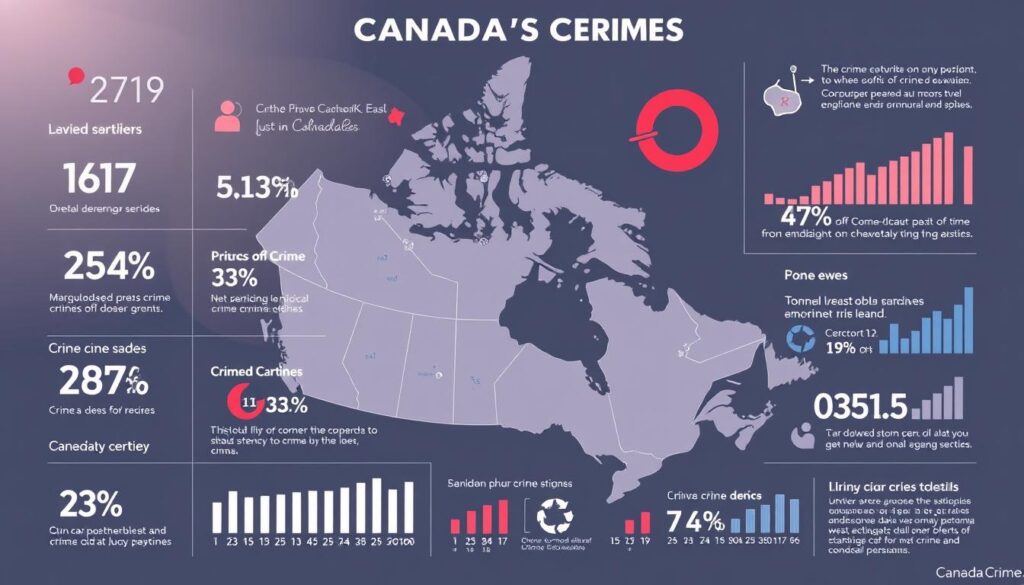In Canada, crime rates are a significant concern, with the police reporting over 2 million crimes annually.
Statistics Canada collects and analyzes crime data through the Uniform Crime Reporting (UCR) Survey, providing valuable insights into crime trends across the country.
The crime statistics reveal that the overall crime rate per 100,000 population has been fluctuating over the years, with some provinces experiencing higher rates than others.
To better understand these trends, it’s essential to examine how crime data is measured, including the Crime Severity Index and per 100,000 population metrics.
By analyzing these statistics, we can gain a deeper understanding of Canada’s crime landscape and the factors influencing it.
The Canadian Criminal Justice System
The Canadian criminal justice system is a complex entity that operates on multiple levels, involving federal, provincial, and municipal authorities. This multi-tiered approach is designed to effectively address crime across different jurisdictions.

Structure and Jurisdiction of Canadian Law Enforcement
Canada’s law enforcement is structured around federal, provincial, and municipal police services. The Royal Canadian Mounted Police (RCMP) serves as the federal police force, while provinces have their own police services, and municipalities often maintain local police departments. This structure creates a network of agencies that must coordinate their efforts to combat crime effectively.
| Level of Government | Law Enforcement Agency | Jurisdiction |
|---|---|---|
| Federal | Royal Canadian Mounted Police (RCMP) | National |
| Provincial | Provincial Police Services | Provincial |
| Municipal | Local Police Departments | Municipal |
Role of Statistics Canada in Crime Reporting
Statistics Canada plays a crucial role in standardizing crime reporting across different law enforcement agencies. Through the Uniform Crime Reporting (UCR) Survey, Statistics Canada collects detailed data on criminal incidents reported to the police, creating a comprehensive national database. The Canadian Centre for Justice and Community Safety Statistics (CCJCSS) analyzes this data to identify trends and produce reports that guide policy decisions over time.
Recent initiatives, such as the Police-reported Indigenous and Racialized Identity Data collection, aim to provide more detailed demographic information about victims and accused persons involved in criminal incidents, enhancing the understanding of crime patterns.
Understanding the Canada Criminal Code
To comprehend the intricacies of crime in Canada, it’s essential to delve into the Canada Criminal Code. The Code is a comprehensive federal statute that codifies most criminal offenses and procedures in Canadian law, providing a unified approach to addressing crime across all provinces and territories.

Historical Development of the Criminal Code
Originally enacted in 1892, the Criminal Code has undergone numerous revisions and amendments over time to reflect evolving societal values, emerging crimes, and changing approaches to justice and rehabilitation. These updates have been crucial in keeping the legal framework relevant and effective in addressing various forms of crime.
Major Categories of Criminal Offenses
The Code categorizes criminal offenses into several major classifications, including crimes against the person (such as violent crime), property crimes, public order offenses, and crimes against the administration of justice. Violent crime includes offenses like homicide, assault, and robbery, while property crimes encompass theft, breaking and entering, fraud, and mischief. Understanding these categories is vital for interpreting crime statistics and trends.
Recent Amendments and Updates
Recent amendments to the Code have addressed emerging issues such as cybercrime, terrorism, cannabis legalization, and reforms to sexual assault laws. These updates demonstrate the Code’s ongoing evolution to address contemporary crime challenges and ensure that the legal framework remains effective and relevant.
Ontario Crime Statistics: A Comprehensive Overview
Crime statistics in Ontario reveal a nuanced picture of safety and criminal activity across different regions. The data indicates significant regional variations in both the volume and nature of criminal activity, with urban centers generally reporting higher crime rates per 100,000 population than rural areas.

Crime Severity Index in Ontario
The Crime Severity Index (CSI) is a key metric for understanding Ontario’s crime landscape. It weighs offenses based on their seriousness as determined by court sentencing patterns, providing a more nuanced view than raw crime counts. Recent data shows that the Greater Toronto Area had a Crime Severity Index of 58.5, representing a 10.8% increase, while Toronto specifically recorded a CSI of 69.2, marking an 11.3% increase year over year.
This increase in CSI highlights the growing concern over crime severity in major urban centers within Ontario.
Violent Crime Rates in Ontario
Violent crime rates in Ontario have shown concerning patterns in certain regions. Toronto reported a violent crime index of 96.0, a 2.5% increase, while some northern communities experience significantly higher rates per 100,000 population. The variation in violent crime rates across different regions underscores the need for targeted intervention strategies.
Property Crime Trends
Property crime trends indicate a substantial increase in certain categories. Toronto’s property crime index rose by 17.8% to reach 59.1, reflecting challenges in addressing theft, break-ins, and other property-related offenses. When analyzing Ontario crime statistics, it’s essential to consider population density, socioeconomic factors, and policing resources, as these variables significantly influence both actual crime rates and reporting patterns.
Understanding these trends is crucial for developing effective crime prevention strategies tailored to the specific needs of different communities across Ontario.
Regional Analysis of Crime in Ontario
Ontario’s diverse regions exhibit unique crime patterns, influenced by local demographics and socioeconomic factors. Understanding these regional variations is crucial for developing effective crime prevention strategies.
Greater Toronto Area Crime Patterns
The Greater Toronto Area (GTA) shows varying crime patterns across its municipalities. For instance, Peel Region reported a Crime Severity Index of 51.4, while Toronto proper had a higher index of 69.2. York Region and Halton Region also reported lower Crime Severity Indices at 54.6 and 31.4, respectively. This variation highlights the need for tailored policing approaches within the GTA.

Ottawa and Eastern Ontario Statistics
Ottawa and Eastern Ontario present a different crime profile. Ottawa’s Crime Severity Index was 55.8, with a 3.1% increase. The violent crime index was 66.5, showing a 1.6% decrease, while the property crime index was 52.0, with a 5.6% increase per 100,000 population. These statistics indicate a complex crime landscape that requires nuanced policing strategies.
| Region | Crime Severity Index | Violent Crime Index | Property Crime Index |
|---|---|---|---|
| Ottawa | 55.8 | 66.5 | 52.0 |
| Thunder Bay | 103.0 | – | – |
Northern Ontario Crime Challenges
Northern Ontario communities face significantly higher crime challenges. Thunder Bay, for example, had a Crime Severity Index of 103.0, nearly double the provincial average. This reflects the unique socioeconomic challenges and limited police resources in these regions. Addressing these challenges requires specialized crime prevention and policing strategies.
Comparing Ontario to Other Canadian Provinces
A comparative analysis of crime statistics across Canadian provinces highlights Ontario’s position in the national landscape. Ontario’s crime rates are often compared to those of other major provinces like Quebec and the western provinces.
Ontario vs. Quebec Crime Rates
Ontario and Quebec share some similarities in their crime profiles. The Crime Severity Index (CSI) for Greater Montréal was 63.2, representing a 2.2% increase, whereas the Greater Toronto Area reported a CSI of 58.5 with a more significant 10.8% increase. Despite these changes, Quebec generally shows more stability in its year-over-year statistics. For more detailed information on Canadian crime statistics, visit the Justice Canada website.
Western Provinces Comparison
Western provinces exhibit higher crime rates per 100,000 population compared to Ontario. For instance, Metro Vancouver in British Columbia had a CSI of 90.2, while Edmonton in Alberta recorded a CSI of 113.3, and Winnipeg in Manitoba reached a high of 135.8. Violent crime rates in these cities are also notably higher, with Toronto reporting a violent crime index of 96.0 per 100,000, contrasting with Edmonton’s 134.5 and Winnipeg’s 207.1. Further analysis on Canada’s crime rates can be found on Canada Crime.
Factors Influencing Regional Differences
Several factors contribute to the regional differences in crime statistics. Population density and urbanization play significant roles, with densely populated areas often showing different crime patterns. Economic factors such as unemployment rates, income inequality, and the presence of resource-based economies also influence crime rates. Additionally, social factors including age demographics, education levels, and access to social services contribute to the variations in crime statistics across provinces.

Crime Prevention Strategies in Ontario
Ontario has adopted a holistic approach to crime prevention, focusing on both the root causes and symptoms of criminal activity. This comprehensive strategy involves collaboration between various stakeholders, including law enforcement agencies, community organizations, and government bodies. The goal is to create a safer environment by addressing the social factors that contribute to crime and by implementing effective prevention programs.
Community-Based Prevention Programs
Community-based prevention programs form the foundation of Ontario’s crime prevention strategy. These initiatives include neighborhood watch groups, youth mentorship programs, and community policing efforts. By engaging the community and addressing issues such as poverty, lack of education, and substance abuse, these programs work to prevent crimes before they occur. Community engagement is key to the success of these initiatives, fostering a collaborative environment where citizens and law enforcement work together to enhance safety.

Law Enforcement Initiatives
Law enforcement initiatives in Ontario have evolved to incorporate data-driven approaches, targeting resources toward high-risk areas and specific crime trends. Police services have developed specialized units focused on particular crime categories, such as violent crime task forces and property crime units. These targeted efforts help to reduce crime rates and improve public safety.
Public Education and Awareness Campaigns
Public education and awareness campaigns are a crucial component of Ontario’s crime prevention strategy. These campaigns help citizens protect themselves from common crimes and encourage the timely reporting of suspicious activities. By adapting their messaging based on the most recent year’s statistical reports, these campaigns remain relevant and effective. For instance, campaigns may focus on emerging property crime trends or provide guidance on how to report crime effectively.
Measuring the effectiveness of these prevention strategies requires ongoing data collection and analysis. Statistics Canada and the Canadian Association of Chiefs of Police are collaborating to improve the quality and detail of crime information available to researchers and policymakers, ensuring that crime prevention efforts are informed by the most accurate and up-to-date data.
Conclusion: The Future of Crime Management in Ontario
The future of crime management in Ontario is poised to be shaped by various factors, including technological advancements and demographic shifts. As the province’s population continues to grow and diversify, crime rates per 100,000 residents may be affected, necessitating adaptive strategies. Crime data and statistics will play a crucial role in informing these strategies, enabling more precise targeting of prevention and enforcement resources.
Factors such as climate change, economic fluctuations, and evolving community expectations will also influence crime patterns and management approaches. The integration of public health approaches with traditional law enforcement strategies may become increasingly important, particularly for addressing violent crime and offenses related to mental health and substance abuse. Continued refinement of data collection methodologies, such as Statistics Canada’s initiatives, will provide a more nuanced understanding of how crime affects different population groups.
Ultimately, the success of crime management in Ontario will depend on balancing immediate public safety concerns with long-term strategies that address the root causes of criminal behavior, leveraging data and statistics to drive decision-making and optimize resource allocation.

